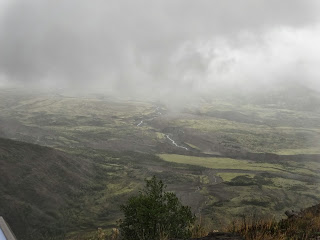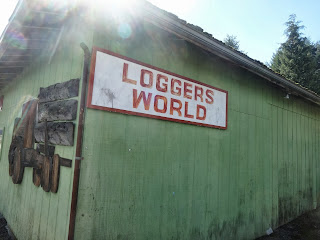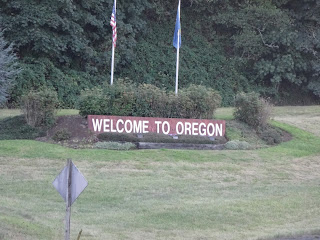59.5 miles in 4:59.....September 26.....today was the gem of the last two weeks, and with 2-3 inches of rain forecast for the next four days, it's the only gem we are going to get. The temps were still in the mid fifties when I rolled out, but the warmth of the dun can make 64 feel pretty good. I got on the weather channel maps and figured out a way to get down the I-5 corridor without the interstate travel, and it worked out pretty well for just winging it. I spent the first 8-10 miles working my way through the cities of Centralia and Chehalis, which are medium size towns, but not big enough to have all the malls and big box stores of bigger cities. I rode through two downtown areas and a lot of residential areas that gradually gave way to country living and some farming. Cows mixed in with cabbage and lettuce fields, the corn stalks say that the corn is still sweet, and some pumpkin and squash fields are ready for harvest. Many people were out cutting their grass since today is the only dry day of last week and next week combined. Y'all know how I love the smell of freshly cut grass, especially when someone else is cutting it! I passed some interesting sights that I took pictures of, and passed through several small towns in Mt. St. Helens country. I couldn't see any damage from that eruption of 1980, but there are some areas that Pam and I would like to explore where damage is still evident. Towns like Toledo, Livingston, Castle Rock, and Kelso made for some interesting riding, without being too congested. The route was split into four segments, including the populated areas early in the ride, Jackson Highway, which was equipped with nice shoulders and little traffic, Barmes Road which was almost rain forest like and took me through a couple of state parks, and Washington 411, which was very undulating with very random shoulder widths from 3inches to 6 ft, and increasing traffic as it got later in the day.
The sun stayed with me for the first three hours of the ride, then an ominous gray cloud swallowed the sun like an eclipse, and I even had five minutes of rain, just in case I had forgotten what it was like.
When I got into the biggest town of the day, Kelso, I followed a river through an industrial area which led me to the Columbia River, and acres and acres of stored logs, getting ready to go to China, probably.
Somewhere during my ride Pam contacted me and told me she wouldn't be following me as planned, because a motor went bad on the step at our door. She spent the day getting that ordered, to be installed tomorrow, so she came in the Jeep, and after some wrong directions, picked me up on US 30, in Oregon. I went across the Lewis and Clark Bridge over the Columbia River, which is the state border. As I waited for her, I watched ocean freighters go up and down the river, trains, trucks, cranes, and a very busy port on both sides of the water. By the time we got home it was dark, with the sun going down a little after 7 PM now. So, we are spending the night again in Centralia, and what happens tomorrow will be dependant on a repaired step motor, and the impending monsoons.
 |
| This area is filled with Christmas tree farms. And they are all perfect trees! |
 |
| This guy had three awesome wood carvings in his yard. |
 |
| Mountain lion and bear |
 |
| Mountain lion close up - check out the eyes! |
 |
| Jackson's cabin |
 |
| For all the ladies! |
 |
| No weak women here! |
 |
| Parked on someone's lot! |
 |
| This is a wall of green moss! Around here all the rocks and concrete bridge walls are covered with moss. |
 |
| Going across the Lewis and Clark bridge |
 |
| Looking down from the L&C bridge - these are piles and piles of logs! |
 |
| Lewis and Clark bridge |
 |
| Washington is filled with all these little espresso/coffee shops. |
 |
| Sign at a gas station. Everything is legal in Washington! |
























































